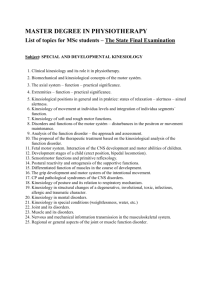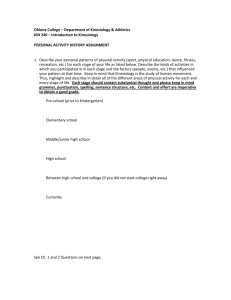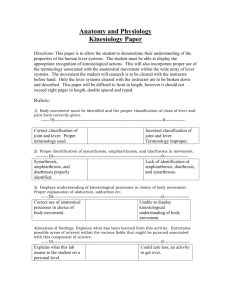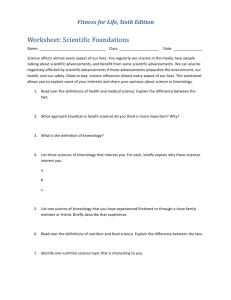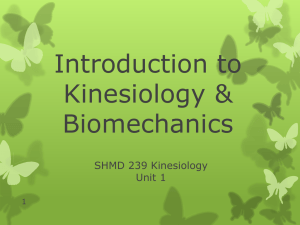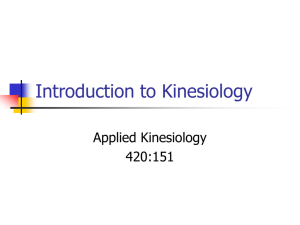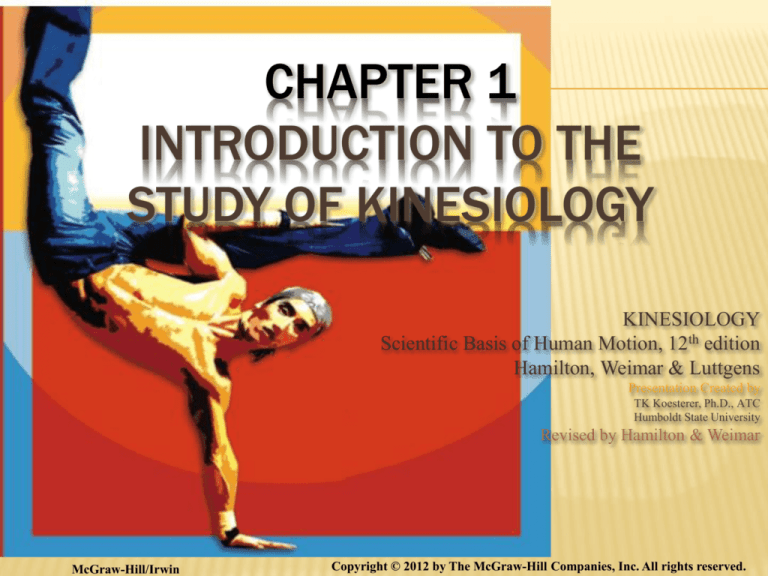
CHAPTER 1
INTRODUCTION TO THE
STUDY OF KINESIOLOGY
KINESIOLOGY
Scientific Basis of Human Motion, 12th edition
Hamilton, Weimar & Luttgens
Presentation Created by
TK Koesterer, Ph.D., ATC
Humboldt State University
Revised by Hamilton & Weimar
McGraw-Hill/Irwin
Copyright © 2012 by The McGraw-Hill Companies, Inc. All rights reserved.
OBJECTIVES
Define kinesiology & explain its importance to the student
of human motion.
Describe major components of a kinesiology analysis.
Describe a selected motor skill;
breaking it down into component phases.
identifying starting and ending points.
Determine simultaneous-sequential nature of movement
skills.
Classify motor skills.
State the mechanical purpose of movement skills
1-2
KINESIOLOGY
The study of human movement from the point
of view of the physical sciences.
Mechanics: Biomechanics
Anatomy: Musculoskeletal anatomy
Physiology: Neuromuscular physiology
Every structure that participates in movements
of the body does so according to physical and
physiological principles.
1-3
SAFETY, EFFECTIVENESS
& EFFICIENCY
The underlying aim of kinesiology is:
Safety: structure movements to avoid doing
harm to the body.
Effectiveness: success or failure of meeting
goals of performance.
Efficiency: striving to achieve movement goal
with least amount of effort.
1-4
METHODS OF STUDY
CONTROLLED LABORATORY STUDIES
Help students gain understanding of the
nature & complexity of human motion.
Primarily qualitative in beginning.
Advanced study include EMG, motion
capture, force transducers & computer
analysis equipment.
As technology advances, new abilities
increase the depth of knowledge and
understanding.
1-5
METHODS OF STUDY
ANALYSIS UNDER EVERYDAY CONDITIONS
Students learn how to apply a knowledge
of kinesiology.
Develop qualitative skills necessary for
accurate observation, diagnosis, and
treatment of faulty motor performance.
1-6
COMPONENTS OF ANALYSIS
Describing a skill in a logical fashion.
Breaking
it down into its elements.
Determining which elements are critical to SEE
principle for performance.
Evaluating performance
Identifying
errors in performance.
Identifying the sources of error.
Prescribing corrections based on appropriate
identification of cause.
1-7
KINESIOLOGICAL ANALYSIS
(TABLE 1.1)
A. Description of the motor skill performance
1. Primary purpose of the skill
Applicable references to speed, accuracy, form, etc.
form
speed
speed &
accuracy
accuracy
1-8
KINESIOLOGICAL ANALYSIS
(TABLE 1.1)
A. Description of the motor skill performance
2. Movement phases
break down motion into “phases”
preparation
Fig 1.2
power
follow through
1-9
KINESIOLOGICAL ANALYSIS
(TABLE 1.1)
A. Description of the motor skill performance
3. Classification of the skill
Classification provides clues to the nature of
anatomical & mechanical requirements of a group
of skills.
1-10
KINESIOLOGICAL ANALYSIS
A. Description of the motor skill performance
4. Simultaneous-sequential nature of motion
Simultaneous – segments move as one
Sequential – segments move in an orderly
sequence
simultaneous
sequential
Fig 1.4
1-11
KINESIOLOGICAL ANALYSIS
(TABLE 1.1)
B. Anatomical analysis
1. Joint actions & segment motions:
Joints involved, and exact movements in the skill?
Any limited range of motion?
Refer to Table 1.2
2. Muscle participation & form of contraction:
Muscles producing joint actions?
Type of contraction?
1-12
Anatomical Analysis Model
Joint
Joint
Action
Segment
Moved
Plane &
Axis
Force
Contraction
Type
Prime
Movers
1-13
KINESIOLOGICAL ANALYSIS
(TABLE 1.1)
B. Anatomical analysis
3. Neuromuscular considerations
Which neuromuscular mechanisms are involved?
What is the nature of involvement?
1-14
KINESIOLOGICAL ANALYSIS
(TABLE 1.1)
B. Anatomical analysis
4. Anatomical principles related to effective & safe
performance:
Which anatomical principles contribute to
efficiency & accuracy?
Which principles are related to avoidance of
injury?
1-15
KINESIOLOGICAL ANALYSIS
C. Mechanical analysis
1. Underlying mechanics objective(s)
Balance: regain stability, attain mobility
Locomotion: travel
Pole vault, long jump, throwing
Manipulation: objects or resistance
Walking, running, skipping
Projection: height, range & accuracy
Jump stop, track start
Weightlifting, writing
Maximum effort: speed, power, & force
Sprinting, power lift, blocking
1-16
C. Mechanical Analysis
2. Nature of the forces causing or impeding motion.
Internal forces
External forces
Modifying forces
3. Identify the critical elements.
4. Mechanical principles that apply
Concerning safety.
Concerning effectiveness.
Concerning efficiency
1-17
D. Prescriptions for improvement of performance
• Indicate how the performance should be changed
so that the principles are no longer violated.
• Strategy for effecting change.
• Concentrate on the causes of error, not on the
symptoms.
1-18

